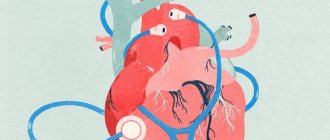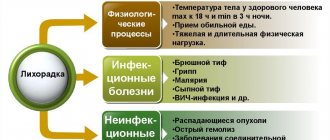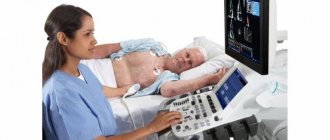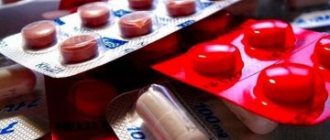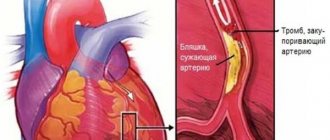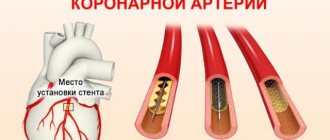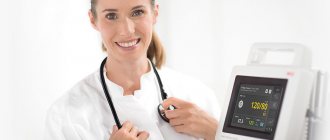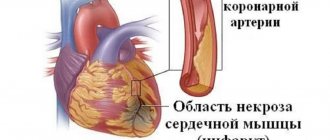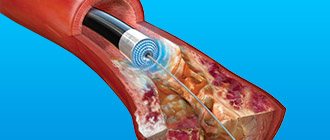0
Author of the article: Marina Dmitrievna
2017.06.02
140
Heart attack
Almost everyone has heard about myocardial infarction. But few people know that its symptoms include not only heart pain. The manifestations of myocardial infarction can almost exactly coincide with the common cold. That is why there is a risk of making a mistake with the diagnosis and making a fatal mistake. To avoid this, it is worth remembering that body temperature during a heart attack can also rise.
Can there be fever in the pre-infarction and acute periods?
Shortly before a heart attack, a person’s immune defense weakens due to disruptions in hemodynamics, which leads to infection entering the body. The indolent condition may persist for several weeks or months.
Signs of a cold sometimes appear against the background of problems with pulmonary ventilation in the pre-infarction state. A person feels a sore throat and constantly coughs. The process is characterized by short-term temperature rises.
The acute phase of a heart attack is characterized by a clinical picture of heart failure and high body temperature up to 39º, associated with the development of the inflammatory process. It is designed to isolate areas of the heart that have undergone necrosis from healthy tissue. This stage sometimes resembles a fever in its manifestations and often provokes complications.
The second cause of fever is the decomposition products of necrotic tissue. They are absorbed into the blood, causing fever and an increase in the level of white blood cells, among which neutrophils dominate.
They are cells that eat decomposition products. The body reacts to them by developing inflammation. In blood tests, the process is manifested by an increase in ESR and a shift of blood to the left.
Signs of fever appear in the acute phase of the disease on day 2. How long it will last depends on the body’s reaction to the pathological process, the presence of other diseases of the cardiovascular system and the size of the dead area.
Causes of increased temperature in the pre-infarction period
In the pre-infarction state, the blood supply is gradually disrupted, the body weakens and becomes vulnerable, easily susceptible to infections. During this period you can easily catch a cold. Difficulty in pulmonary ventilation also causes symptoms similar to the onset of an infectious viral cold. A slight sore throat and the desire to cough are very typical. This is when a slight rise in body temperature is initially observed, which usually passes quickly. However, the sluggish state before a heart attack often resembles a cold with temperature changes. It can last several months, which should already be alarming.
Features of fever due to inflammation
Necrotic changes during a heart attack affect the myocardium and gradually reach the endocardium, which is the inner layer of the heart muscle. The process is manifested by inflammation and parietal thromboendocarditis (formation of blood clots in the cavities of the heart), which causes fever in the patient.
A febrile state may be a consequence of other complications that occur during a heart attack:
- Exudative endocarditis is characterized by the development of inflammation of the pericardial layers. Effusion begins to accumulate in the pericardial cavity due to malabsorption, which leads to fever in the patient.
- With fibrinous pericarditis, the temperature initially increases due to the process of tissue necrosis against the background of leukocytosis.
What causes hyperthermia (causes)?
Severe myocardial infarction affects the production of white blood cells. This can lead to leukopenia (the percentage of white blood cell production decreases sharply). Such processes are observed in elderly patients. The erythrocyte sedimentation rate increases, leading to a febrile state.
The reasons for these changes are the following:
- infectious processes with damage to the heart and arteries;
- decreased tone of the heart muscle;
- anemia;
- tissue inflammation and destruction.
Reasons for temperature changes
Body temperature during a heart attack can vary depending on its shape and the body's reaction. A pathological process that has passed from the acute stage to the acute stage is characterized by a decrease in vascular tone and pressure, which is caused by a decrease in the amount of venous blood entering the heart muscle. Hypoxia (starvation) of the brain gradually develops. It causes dysfunction of internal organs and neurological symptoms. This condition is called cardiac collapse. If no other complications occur, the temperature will be normal or even low.
With an extensive heart attack and its severe tolerance by the body, the synthesis of leukocytes decreases. The problem concerns elderly patients. It is several times more common in women. Against the background of the development of pathological changes, the ESR increases, to which the body reacts with a persistent increase in temperature. The reasons for this phenomenon are as follows:
- development of infection;
- anemia;
- serious damage to tissue structures;
- myomalacia;
- perifocal inflammation.
The presence of infection can be indicated when a febrile state develops. It is characterized by a high temperature after a heart attack, which persists for more than 1-2 weeks.
Myocardial infarction
Myocardial infarction is one of the clinical forms of coronary artery disease, which is accompanied by the development of ischemic necrosis of the myocardium due to circulatory disorders in this area. According to statistics, this disease most often develops in males (half as often in females) in the age range from forty to sixty years. The risk of death from myocardial infarction is especially high during the first two hours from its onset
Myocardial infarction - causes
In most cases, myocardial infarction affects people who lead an insufficiently active lifestyle due to psycho-emotional overload. However, a sedentary lifestyle is not a determining factor in the development of this disease, and a heart attack can unexpectedly strike even young people with good physical fitness. The main reasons contributing to the development of myocardial infarction include: bad habits (smoking, drinking alcohol), hypertension, insufficient physical activity, excess animal fats in the food consumed, unhealthy diet, overeating, obesity. Physically active people are several times less likely to develop a heart attack than those who lead a sedentary lifestyle for certain reasons.
The heart is a muscular sac that works like a pump and drives blood through itself. The heart muscle itself is supplied with oxygen through blood vessels that approach it from the outside. For some reason, some of these vessels become clogged with atherosclerotic plaques, as a result of which they cannot pass the required volumes of blood. Coronary heart disease (CHD) develops. Myocardial infarction develops as a result of a sudden complete stop of blood supply to part of the heart muscle due to blockage of the coronary artery. Most often, this is caused by a developed blood clot on an atherosclerotic plaque, much less often by a spasm of the coronary artery. The area of the heart muscle deprived of nutrition dies. Heart attack - dead tissue (lat.)
Myocardial infarction - symptoms
The main typical symptom of this disease is intense pain in the heart and behind the sternum. The pain occurs unexpectedly, in the shortest possible time reaching great severity and “radiating” to the interscapular space, the left shoulder blade, the lower jaw and the left arm. Unlike the pain observed with angina pectoris, pain during myocardial infarction is much more intense and does not go away after taking nitroglycerin (sometimes it is not eliminated even by injections of morphine). In such patients, it is necessary to take into account the presence of coronary artery disease during the course of the disease, as well as the displacement of pain in the left arm, lower jaw and neck. In addition, in older people, this disease can manifest itself in the form of shortness of breath and loss of consciousness.
In 50% of patients, harbingers of a heart attack are angina attacks that change in intensity and frequency. They become more persistent, occur much more often even with slight physical stress (sometimes they can occur even at rest), last longer, and in their intervals in the area of the heart there remains a feeling of pressure or dull pain. Sometimes a heart attack may be preceded not by pain, but by dizziness and general weakness.
In 15% of patients, an attack of pain lasts no more than one hour, in 40% of patients from two to twelve hours, in 45% of patients - about one day.
In some patients, myocardial infarction is accompanied by sudden shock and collapse. The patient turns pale, feels dizzy and severely weak, breaks out in sweat, and may experience short-term loss of consciousness, nausea, vomiting, and diarrhea (rarely). The patient is haunted by a feeling of intense thirst. The skin becomes moist, gradually taking on an ash-gray tint, and the tip of the nose and limbs are cold, blood pressure drops sharply (sometimes it may not be detected at all). The pulse on the radial artery cannot be felt at all or is very weak. During collapse, the number of heartbeats may be slightly reduced, slightly increased or normal (tachycardia is more often observed), body temperature is slightly increased. If collapse and shock continue for many hours and even days, the prognosis for a normal outcome worsens significantly. With myocardial infarction, serious disorders of the gastrointestinal tract can be observed - intestinal paresis, pain in the epigastric region, nausea and vomiting. No less serious disorders can be observed from the central nervous system - fainting, short-term loss of consciousness, general weakness, difficult to eliminate persistent hiccups. With myocardial infarction, serious cerebral circulation disorders may develop, manifested by paresis, convulsions, coma, and speech impairment.
In addition to the specific symptoms described above, patients may experience general symptoms: the number of red blood cells in the blood increases and other biochemical changes are observed, fever appears, body temperature does not exceed the threshold of 38 * C
Clinical forms of myocardial infarction:
— Asthmatic form (the disease begins with an attack of cardiac asthma)
— Anginal form (a heart attack begins with pain attacks in the heart and behind the sternum)
— Abdominal form (begins with dyspeptic symptoms and pain in the upper abdomen)
— Collaptoid form (the disease is preceded by collapse)
— Cerebral form (the disease begins with focal neurological symptoms)
— Mixed form
— Painless form (latent onset of myocardial infarction)
Atypical forms of myocardial infarction
In addition to the tearing, sharp pain behind the sternum characteristic of a heart attack, there are several forms of heart attack that do not manifest themselves at all, or are disguised as other various diseases of the internal organs.
Painless form of heart attack. This form is manifested by a feeling of discomfort in the chest, severe sweating, deterioration of mood and sleep. This form of heart attack most often occurs in old and elderly people, especially with concomitant diabetes mellitus.
Asthmatic form of myocardial infarction. This type of heart attack is very similar in its manifestations to an attack of bronchial asthma and is manifested by a feeling of congestion in the chest and a dry hacking cough.
Gastric form of myocardial infarction. Its symptoms are very similar to an exacerbation of gastritis and are characterized by severe pain in the epigastric region. On palpation, tension and soreness of the muscles of the anterior abdominal wall are noted. In the gastric variant, the lower parts of the myocardium of the left ventricle adjacent to the diaphragm are most often affected.
Diagnosis of myocardial infarction
The diagnosis is established based on a clinical assessment of the patient’s general condition and after differential diagnosis with diseases such as acute pericarditis, dissecting aortic aneurysm, pulmonary embolism and spontaneous pneumothorax. One of the leading diagnostic methods is an electrocardiographic study (ECG), based on the data of which one can judge the localization and extent of myocardial damage and how long ago the process has developed. A heart attack is characterized by changes in laboratory blood parameters: the level of cardiac-specific markers – cardiomyocytes – increases
Myocardial infarction - treatment
The main goal of treating a patient with acute myocardial infarction is to restore and further maintain blood circulation to the affected area of the heart muscle as quickly as possible. The following medications are used for this:
— Acetylsalicylic acid (aspirin) – due to platelet inhibition, the formation of blood clots is prevented
- Prasugrel, Ticlopidine, Clopidogrel (Plavix) - also prevent blood clot formation, but are much more powerful than aspirin
- Bivalirudin, Fraxiparin, Lovenox, Heparin - anticoagulants that prevent the formation and spread of blood clots and affect blood clotting
— Reteplase, Alteplase, Streptokinase are powerful thrombolytic drugs that can dissolve an already formed blood clot
All of the above drugs are used in combination and are vital for the successful treatment of myocardial infarction.
The best modern method of restoring blood flow in the coronary artery is immediate angioplasty of the coronary artery followed by installation of a coronary stent. If for some reason angioplasty cannot be performed during the first hour of a heart attack, the use of thrombolytic drugs is preferable.
If all of the above measures are impossible or do not help, the only means to restore blood circulation (save the myocardium) is urgent coronary artery bypass grafting.
The most critical are the first days of the disease. The further prognosis directly depends on the degree of damage to the heart muscle, the timeliness of measures taken and the presence of concomitant cardiovascular diseases.
More articles on this topic:
Clinical picture
Temperature readings may vary depending on the characteristics of the patient’s body and the stage of the disease:
- In the first days after the attack, the patient experiences fever closer to bedtime. Sometimes it appears a couple of hours after the cessation of acute pain due to a neuro-reflex reaction.
- Closer to the third day, the temperature rises up to 38º. It is typical for most patients and persists virtually until the end of the acute phase.
- The fever due to the inflammatory process does not exceed 38º and lasts for 3-5 days.
- A large heart attack is characterized by high fever for 1-2 weeks.
- A fever that does not subside for 14 days or more indicates that the disease has progressed to a complicated form.
- An increase in readings up to 39-40º is a frequent sign of the addition of other diseases (pneumonia, pyelonephritis) to a heart attack.
The patient's age influences the temperature response. In young people, the fever is more pronounced, and in old age the indicators may remain within the normal range.
With the development of cardiogenic shock, the temperature drops against the background of decreased contractile function and impaired myocardial nutrition.
Increased temperature in heart disease: causes, symptoms, treatment
Not only high, but also constant low-grade fever can cause complications in people with cardiac diseases.
What to do when it increases and how to prevent dangerous health problems? So, today it’s worth telling you about a sharp increase and decrease in body temperature without symptoms in an adult and a child, associated with cardiac problems.
How dangerous is this phenomenon?
Patients with heart disease constantly suffer from a wide variety of symptoms. High body temperature and a feverish state can be triggered by various factors, but with cardiac problems, even a short increase in temperature negatively affects the heart. The number of contractions increases (sometimes 2 times!), and the heart endures excessive stress.
This video will tell you about a sudden increase in temperature without symptoms:
Varieties of the trait
Temperature increases are divided into categories:
- very high (more than 39 C);
- moderately elevated (37-38 C);
- low-grade fever.
We will talk about the signs of the process of increasing body temperature below.
Folk remedies
There are enough recipes from alternative medicine that have an antipyretic effect. Along with prescribed medications, it is also worth using decoctions aimed at strengthening muscles and reducing inflammation (from rose hips, hawthorn). It is better to consult your doctor regarding the use of each recipe.
The following recipes can help with cardiac pathology that provokes fever:
- Drinking plenty of fluids includes not only water, but also, for example, fruit drinks. Particular attention should be paid to decoctions and fruit drinks made from cranberries, lingonberries, sea buckthorn, and currants.
- A decoction can be prepared from claspberry, elderberry leaves and nettle. Rosehip, rowan and linden tea also have antipyretic properties.
- Honey (0.5 tbsp) is mixed with propolis and crushed garlic (1 tsp each). Take 4-5 spoons per day.
- Lemon juice is mixed with water and honey is added. Leave the product for 20 minutes and drink. You can repeat the reception up to 4 times a day.
- To relieve heat, apply a potato compress to the forehead. Raw potato gruel is mixed with apple cider vinegar (1 tbsp) and applied to the forehead (in gauze). If necessary, the compress is changed periodically.
Among the folk remedies for fever, you need to avoid recipes containing Rhodiola rosea and St. John's wort. And, of course, self-medication can be dangerous, so neglecting qualified help is not recommended.
This video will tell you about folk remedies and methods that help lower the temperature:
Source: https://gidmed.com/kardiologiya/simptomy-kard/povyshenie-i-ponizhenie-temperatury.html
Diagnosis of heart attack with hyperemia
Fever during myocardial infarction allows the doctor to suspect the development of new necrotic foci, as it is accompanied by changes in blood composition:
- A decrease in the concentration of granular eosinophils (one of the types of red blood cells) occurs in the first days after a heart attack. Their decrease is associated with the accumulation of decay products of necrotic tissue.
- An increase in ESR (erythrocyte sedimentation rate) is detected on day 3. It will reach its peak by day 10. It will take approximately 1 month for the ESR level to normalize. This sign is especially important when differentiating from angina pectoris. It is not manifested by an increase in erythrocyte sedimentation rate and high temperature.
- An increase in CPK (creatine phosphokinase) activity is perceived as a marker of infarction. It reaches its maximum by the second day. The reason for the increase in the enzyme is the necrosis of cardiac tissue and the release of breakdown products into the blood. In diseases of the liver, lungs and angina pectoris, its level does not change.
- The activity of liver enzymes (transaminases) increases. They return to normal after a week.
The “silent” form of heart attack, which often occurs in females suffering from diabetes, may not manifest itself. The fever that occurs on day 2 will be the only symptom indicating intoxication with decay products of tissues that have undergone necrotic changes.
What mechanism underlies hyperthermia?
In response to the formed necrotic focus, an inflammatory process develops in the body. This is a universal protective reaction designed to eliminate the traumatic factor and restore damaged tissue. The cause of inflammation is metabolic products that have changed their properties as a result of necrosis, hemorrhage or thrombosis.
Any inflammatory process in the body is accompanied by an increase in temperature under the influence of pyrogens (biological compounds that can affect the thermoregulation center).
In the case of an uncomplicated heart attack, the fever is non-infectious. Neutrophilic leukocytes, macrophages and mononuclear cells migrate to the dead area to limit the source of inflammation and absorb tissue breakdown products.
Leukocytes produce pyrogenic substances that cause an increase in temperature: interleukins, interferons, tumor necrosis factor.
When released into the blood, leukopyrogens provoke:
- rapid increase in body temperature;
- increased heart rate;
- increased sweating;
- headache.
Fever may also occur due to complications.
Hypostatic pneumonia appears 5-7 days after the onset of the disease Her reasons:
- decreased blood supply to the lungs;
- deterioration of their ventilation;
- forced physical inactivity;
- the presence of opportunistic microflora, nosocomial infections;
- violation of the rules of patient care in intensive care;
- decrease in the body's overall resistance.
In addition to the increase in temperature, the patient has a cough, shortness of breath, general weakness, clinically - a decrease in the amount of oxygen in the blood, neutrophilic leukocytosis, and areas of darkening on the radiograph. In the case of pneumonia, the fever is infectious and requires antibiotic treatment.
In the long-term period, fever is caused by the development of parietal thromboendocarditis and post-infarction syndrome (Dressler).
Parietal thromboendocarditis develops at 3-4 weeks in patients who have had extensive transmural or subendocardial myocardial infarction. Small detached blood clots, entering the systemic bloodstream, cause blockage of blood vessels in the brain, kidneys, and intestines, which can be accompanied by fever.
Dressler's syndrome develops at 3-6 weeks of illness. The process is based on a delayed-type hypersensitivity reaction. Circulating immune complexes formed with autoantibodies settle on the serous membranes, causing their inflammation.
Clinical signs:
- Fever up to 39-400C.
- Polyserositis (pneumonitis, pleurisy, pericarditis, synovitis of large joints).
- Pain on palpation of the sternocostal and sternoclavicular joints.
- Acceleration of ESR, eosinophilia, leukocytosis.
- Rarely - hemorrhagic vasculitis, kidney damage.
In rare cases, a rise in body temperature may occur at the same time as the onset of a heart attack. This is explained by the release of a large amount of adrenaline into the blood and psychogenic stimulation of the thermoregulation center. Also, temporary fever accompanies myocardial reperfusion after balloon angioplasty and coronary stenting.
Temperature reaction at other stages of infarction
The patient, who is in the subacute stage of the disease, experiences relief. The pain syndrome disappears, and the body temperature becomes normal. The patient is discharged to undergo a period of rehabilitation at home, but under the supervision of the attending physician.
A protracted form of recurrent infarction occurs due to repeated infection in the body. The fault lies with the incomplete process of tissue breakdown of the affected area of the myocardium and slow scarring. The temperature may rise even 2-3 months after the first manifestation of the disease. Often the problem concerns elderly patients or people with advanced atherosclerosis. Necrotic changes affect not only the tissues affected by the first attack, but also those nearby.
Folk remedies and advice
To eliminate this unpleasant symptom, you can use the following folk recipes:
- Berry tea for fever. You will need cranberries, raspberries, and strawberries. Pour the washed collection into the container. Pour boiling water for 20 minutes. Strain and drink warm with 1 tablespoon of honey. It is advisable to drink the decoction at night. It has antipyretic properties.
- A decoction based on dry raw materials. Pour 2 tablespoons of chamomile flowers, rose hips, dried strawberry and raspberry leaves into a glass container. Fill with hot water. Leave for no more than 1 hour. Strain. Warm until warm before each use.
- Berry puree. Grind fresh cranberries and viburnum on a fine grater. Add 2 tablespoons of sugar or honey. Take a quarter of an hour before meals. Take a decoction of chamomile.
- Dried fruits compote. Pour 1 piece of dried apricots, raisins and prunes into an enamel pan. Pour water and put on low heat for 40 minutes. Leave for 20 minutes. During this time, the compote will become warm. Drink at any time of the day.
- Lemon based fever remedy. Squeeze lemon juice, add 1 tsp. honey and add only warm water. Lemon is rich in vitamin C, but upon contact with boiling water, a process of decomposition occurs. And such a remedy does not bring any effect.
- Vinegar compress. Vinegar is a powerful remedy for fever. Apple or table variety will do.
Dilute 1 tbsp. l. product in 1 liter of warm water. Place the patient on the bed and remove outer clothing. Rub your feet and hands with a pre-moistened rag or towel in the solution. The lower limbs must be rubbed from the hips to the toes. Hands - from the shoulder. The chest and collarbones are also treated. Wet the handkerchief and place it on the patient's forehead. Change the dressing every 5 minutes.
Measure your body temperature every 30 minutes. If it subsides slowly, wet socks (preferably cotton) and put them on the patient. Remove socks after 40 minutes. Remember that if a person has cool feet, it is advisable not to apply a compress, as this can cause spasms.
- Alcohol rubbing. Dilute alcohol or vodka, keeping the proportions 1:1. Dampen a natural cloth and rub onto elbows, wrists and armpits.
- Potato compresses. Peel and rinse raw potatoes. Grate and add 1 teaspoon of vinegar. Wrap in a gauze bandage or bandage and apply to your temples and forehead. Leave for 20 minutes. If the temperature does not subside, repeat the compress every 30-40 minutes.
- Onion compresses. Grind the peeled onion into a paste and add vinegar (1 teaspoon). Wrap in gauze and place on forehead. To avoid triggering a tear reaction, place swabs or a handkerchief soaked in cold water over your eyes. Onion porridge can also be used on the feet.
“Grandma’s” recipes have proven themselves to be the best in practice, but still, before deciding to use them, consult a specialist. Individual intolerance to the components of the products and other possible contraindications should be excluded.
Reaction to relapses
Under the influence of diseases of the cardiovascular system (hypertension, ischemia, heart failure) and other factors (bad habits, obesity), a second heart attack may occur. It manifests itself regardless of the stage of the scarring process of the affected tissues. Relapse occurs most often in the first year after the attack. Especially among males aged 40 to 60 years. The chances of re-development of the pathology are significantly higher in people with extensive myocardial damage.
Recurrent infarction is difficult to detect using an electrocardiograph and may appear atypical (unusual). Its course is severe. The patient suffers from high fever, irregular heartbeat and signs of heart failure. The chance of death increases significantly. To make a quick diagnosis and draw up an effective treatment regimen, it is necessary to study changes in the composition of the blood within a week.
Signs of heart disease: symptoms and recommendations
Article last updated 09.09.2019
Elevated body temperature is not a sign of heart failure, but this symptom should be treated with particular caution. People suffering from heart failure, especially the elderly, are predisposed to any infections and suffer them more severely than others. A common cold can worsen the course of cardiac pathology and lead to serious consequences.
First of all, it must be said that temperatures below 37-37.3 degrees are regarded as normal. If the numbers are higher, then you need to look for the source.
Early signs of a heart attack
Temperature increases are divided into categories:
- very high (more than 39 C);
- moderately elevated (37-38 C);
- low-grade fever.
We will talk about the signs of the process of increasing body temperature below.
As already mentioned, chest discomfort can have various causes. Heart diseases are identified by certain characteristic signs.
You should know that the “core” often does not experience any unpleasant sensations. At the same time, a person with other pathologies may complain that it is difficult for him to breathe or his heart hurts.
However, these symptoms will have nothing to do with cardiac diseases.
1. Compressive, pressing pain behind the sternum, radiating to the back, arm, neck, jaw, especially to the left side. Accompanied by shortness of breath, sweating, nausea.
2. Pain occurs after exertion, physical or psychological, and goes away with rest and after taking nitroglycerin.
3. Shortness of breath occurs during exertion, even during everyday work that is not too hard, while eating, or while lying down. On the eve of an attack, a person may sleep sitting or suffer from insomnia.
4. Increased fatigue from normal work can haunt a person several months before the attack.
5. Men may suffer from erectile dysfunction for several years before being diagnosed with coronary artery disease.
6. Edema is one of the characteristic signs of cardiac dysfunction. At first they are insignificant, but gradually become more noticeable, especially visible in the rings on the fingers and on the shoes. If edema appears, it is necessary to undergo examination by a cardiologist or therapist.
7. Sleep apnea, or stopping breathing during sleep, and snoring can signal a predisposition to a heart attack.
very high (more than 39 C); moderately elevated (37-38 C); low-grade fever.
Temperature response to thrombolytic treatment
Myocardial infarction is a consequence of the development of atherosclerosis. Atherosclerotic plaques gradually begin to form on the walls of the coronary vessels, narrowing the lumen and aggravating the lack of nutrition of the heart muscle. Over time, cracks appear on them, into which platelets are directed, which leads to the formation of blood clots. Thrombolytic therapy helps restore blood flow. It is especially important in the first hours after the onset of pathology, since the likelihood of saving a large area of the myocardium from necrotic changes will increase.
To dissolve blood clots, medications (“Tenecteplase”, “Alteplase”) are used, aimed at increasing the fibrinolytic activity of the blood. The effect occurs due to the transition of plasminogen to plasmin. The medicine is administered intravenously. Improvement occurs gradually. During thrombolytic treatment, adverse reactions (fever, arrhythmia, vomiting, hypotension) often occur. To prevent them, it is advisable to combine the administration of thrombolytics with Acetylsalicylic acid and Heparin. Such drugs should be administered immediately after diagnosis to stop the formation of blood clots.
Complications
The temperature often rises with the development of complications of myocardial infarction:
- The manifestation of pulmonary edema (accumulation of fluid in the pulmonary interstitium) against the background of necrotic changes in the heart muscle is a consequence of narrowing of the lumen of blood vessels and the formation of blood clots in the right ventricle. Sometimes the reason is left ventricular failure, which led to the development of a congestive process in the pulmonary circulation and the formation of blood clots in the pulmonary arteries. Complications include fever, arrhythmia, shortness of breath, chest pain and cough with sputum production.
- During the recovery period, the temperature may increase due to the development of ischemic cardiopathy and inflammation of the pericardium. The pain resembles the acute stage of a heart attack and can be aggravated by breathing and body position.
- The development of post-infarction pericarditis contributes to an increase in the number of leukocytes, against the background of which the patient exhibits signs of a cold, including fever.
Reaction to Dressler's syndrome
Inflammation of the tissues of the heart muscle and lungs, which occurs 1-2 months after a myocardial infarction, is called Dressler syndrome. It was discovered by the scientist William Dressler in the 50s of the previous century. This post-infarction syndrome is an autoimmune disorder characterized by inflammation of the pleura, lungs, pericardial layer of the heart and joints. It is accompanied by high body temperature.
The reason for the development of complications is the attack of the immune system on its own cells. Dressler syndrome is expressed in one or more pathological processes:
- Pericarditis manifests itself much more mildly than usual. The temperature does not exceed 38º. The severity of symptoms decreases after 2-3 days.
- Pleurisy is characterized by cough, shortness of breath, low fever and acute pain, which noticeably intensifies with breathing. Its focus is localized in the chest area.
- Pneumonia caused by an autoimmune malfunction is manifested by fever and severe shortness of breath.
- Arthritis mostly affects the left shoulder joint. Its inner lining becomes inflamed, which is expressed by pain and low-grade fever (slight increase in temperature).
- Polyarthritis has an inflammatory-allergic nature of manifestation. He is characterized by a feeling of numbness and pain near the affected joints.
The combination of foci of inflammation aggravates the course of a heart attack and makes the body’s temperature response stronger and more persistent. Mild forms of pre-infarction syndrome are no less dangerous. They are detected only through a blood test. The presence of a pathological process can be suspected by persistent pain in the joints and low-grade fever.
Similar forms of Dressler's syndrome occur due to hypoxia of the myocardium and other organs. Cardiomyocytes (heart cells) are damaged, resulting in the production of antibodies. They are destroyed by the immune system, and then it switches to healthy cells of its own body. An autoimmune process is characteristic of an extensive form of infarction.
Non-steroidal anti-inflammatory drugs are used as treatment. Advanced cases require the use of corticosteroid hormones.
Chronic course of heart attack
The chronic type of heart attack manifests itself paroxysmally. The patient periodically experiences symptoms (shortness of breath, chest pain) characteristic of his acute phase. Against the background of pain, body temperature often rises. The severity of symptoms decreases only after 2-3 days.
In rare cases, low-grade fever persists even after the end of the painful attack. Upon his return the fever intensifies. Such a wave-like febrile state resembles the course of rheumatic endocarditis and may even occur due to it. In this case, systolic murmurs will be clearly audible during auscultation.
Can the temperature rise during a heart attack?
At its core, acute myocardial infarction (AMI) is aseptic necrosis of heart tissue.
Cardiomyocytes die 6-8 hours after the attack, the inflammatory process begins and the temperature rises. Hyperthermia often appears on days 2-4 and can last up to 10 days - until the formation of connective tissue and the beginning of consolidation of the scar.
Fever can also be a manifestation of complications of myocardial infarction: embolism in the systemic circulation, hypostatic pneumonia. In the long term, high temperature is accompanied by post-infarction Dressler syndrome.
Typically, fever during AMI is subfebrile (37.5-390C) and fluctuates during the day within 1-20C.
It is important to consider that an isolated increase in temperature without changes in biochemical markers of infarction (troponins, CF-CPK) and changes in the ECG cannot be a consequence of myocardial necrosis.
Temperature reaction to the operation performed
The stenting procedure is performed to widen coronary vessels narrowed due to the formation of atherosclerotic plaques. The stent is a frame made of metal and placed on a small balloon. It is injected into the femoral artery and then sent to the heart muscle. In the required place, it swells, expanding the lumen of the vessel and restoring blood supply to the heart.
An increase in body temperature is one of the postoperative abnormalities:
- the appearance of pain and swelling at the puncture site;
- the occurrence of symptoms of infection;
- numbness of the area where the puncture was made to insert the catheter;
- excessive sweating;
- incessant vomiting;
- pain in the chest area;
- arrhythmia;
- manifestations of cough and shortness of breath;
- problems with urination.
Detection of any symptoms after stenting should be a signal to go to the hospital. They are often the result of an infection or an incorrectly performed procedure, so it is necessary to urgently consult a doctor to avoid the development of complications.
Temperature is one of the signs of myocardial infarction. It indicates the development of inflammatory processes characteristic of necrotic changes in the tissue of the heart muscle. Only the attending physician can understand why this symptom appeared, based on the results of instrumental diagnostics and laboratory tests. It is enough for an ordinary person to consult a specialist in a timely manner to prevent the development of complications and alleviate their condition.
How to prevent hyperthermia?
After a course of therapy, the patient must undergo rehabilitation. Next, do physical exercises at home. It is imperative to measure your body temperature daily to prevent hyperthermia from occurring again. It is also necessary to adhere to the following recommendations that cardiologists give to their patients:
- correct daily routine;
- proper nutrition without overeating;
- avoidance of conflicts and stressful situations;
- adequate sleep of at least 8 hours;
- eliminate bad habits (tobacco smoking, alcohol abuse, etc.).
Measures to prevent hyperthermia actually come down to preventing recurrent myocardial infarction. If a person manages to avoid a new attack, then, accordingly, an increase in temperature against this background will not occur.
High body temperature is one of the symptoms of myocardial infarction. And, no matter how strange it may sound, in some cases hyperthermia causes serious complications. Therefore, we should not ignore such a familiar symptom, but seek qualified medical help.
